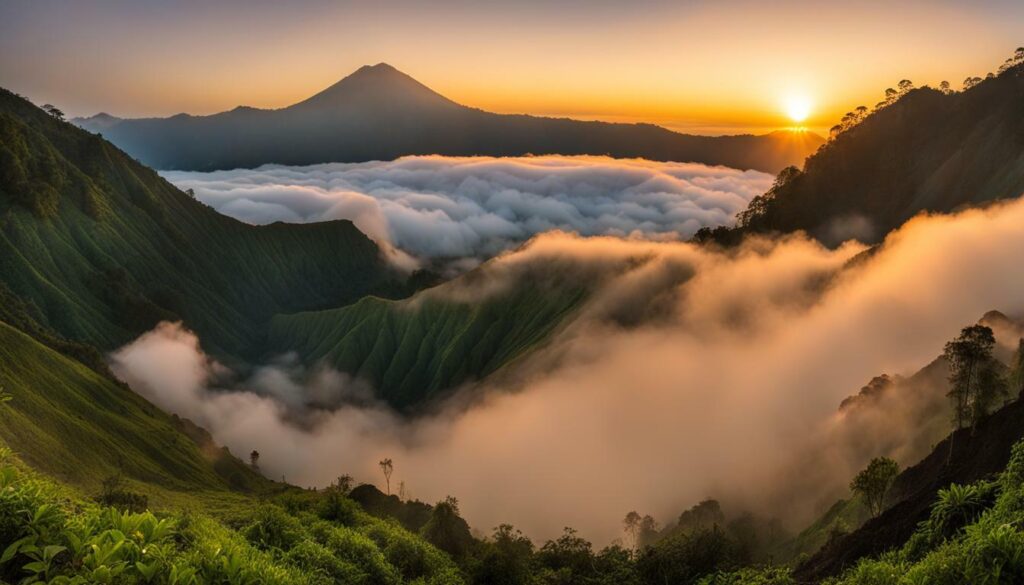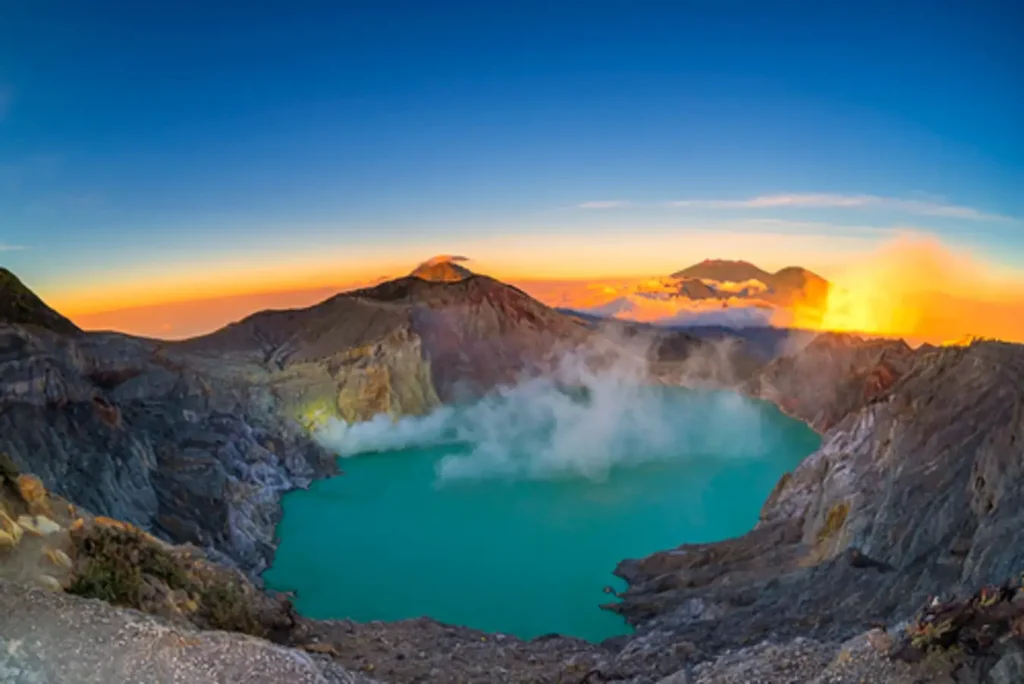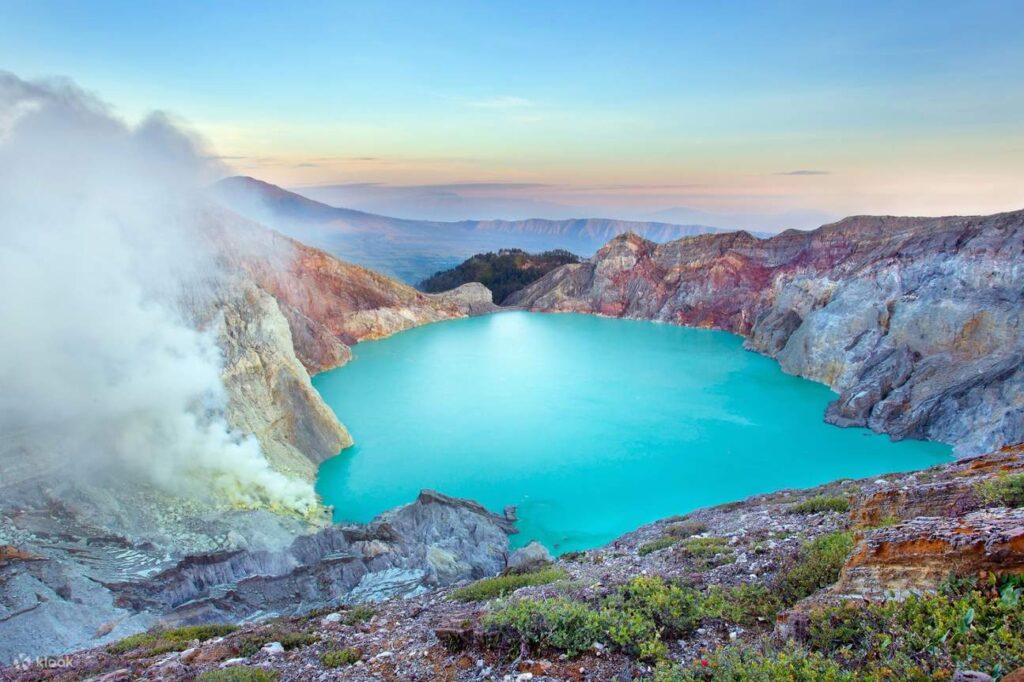Located in East Java, Indonesia, Ijen Crater is a breathtaking natural wonder with an ever-changing climate. The weather conditions at this site are influenced by a variety of factors, from altitude and geographic location to seasonal variations and nearby volcanic activity.
Understanding the weather patterns at Ijen Crater is essential for planning your visit, whether you’re there to witness the stunning blue flames or hike the scenic trails. In this article, we’ll explore the weather conditions at Ijen Crater, provide a weather forecast for your trip, and offer tips on the best time to visit based on the climate.
Key Takeaways:
- The weather at Ijen Crater is influenced by factors such as altitude, geographic location, and volcanic activity.
- Understanding the climate patterns at Ijen Crater is essential for planning your trip.
- A weather forecast can help you prepare for your visit to Ijen Crater.
- The best time to visit Ijen Crater depends on the weather conditions, such as temperature, rainfall, and visibility.
- Stay informed about the current weather conditions and prepare accordingly for a safe and enjoyable experience.
Understanding Ijen Crater’s Climate
Located in East Java, Indonesia, Ijen Crater experiences a tropical rainforest climate, characterized by high temperatures and plenty of rainfall throughout the year. The temperature can range from 14°C (57°F) to 27°C (81°F) at the crater rim, with cooler temperatures at higher elevations. The climate is influenced by several factors, including altitude, monsoon seasons, and the proximity to the equator.
The rainy season occurs from November to March, with the heaviest rainfall in December and January. During this time, the crater may be cloudy and misty, making it difficult to see the iconic blue flames. However, the rainy season also brings lush greenery and scenic waterfalls to the area, making it a beautiful time to visit.
The dry season occurs from April to October, with the driest months being July to September. The weather during this time is optimal for hiking and exploring, with clear skies and cooler temperatures. However, the dry season also brings more visitors to the area, so it may be crowded during peak months.
It’s important to note that the climate can vary throughout the day and at different elevations. The temperature can drop significantly in the early hours of the morning, so it’s essential to bring warm clothing for those planning to make the pre-dawn hike up to the crater.
Overall, the best time to visit Ijen Crater depends on personal preference and the activities planned. Those interested in seeing the blue flames should plan their trip during the dry season, while those looking for lush greenery and waterfalls may prefer the rainy season. No matter when you visit, be sure to pack accordingly and stay informed about the current weather conditions.
Planning Your Journey: Best Time to Visit Ijen Crater
Choosing the right time to visit Ijen Crater is essential to ensure a comfortable and safe trekking experience. The best time to visit Ijen Crater is during the dry season, which runs from May to September, when the weather is generally sunny and dry, and the temperature is cooler.
The wet season, from October to April, brings heavy rainfall, making the trails slippery and muddy and reducing visibility. It is not recommended to trek during this period, as it can be dangerous and uncomfortable.
In addition to the season, other factors such as altitude, proximity to the equator, and the surrounding landscape can affect the weather conditions at Ijen Crater. It is important to check the weather conditions before planning your trip and pack the appropriate gear accordingly.
Pro Tip: The temperature at Ijen Crater can drop significantly at night, so make sure to bring warm clothing for the early morning trek.
Ijen Crater Weather Forecast: What to Expect
Before embarking on your journey to Ijen Crater, it’s important to check the latest weather forecast. Being prepared for the weather conditions can ensure a safe and enjoyable experience.
There are several resources available to get up-to-date information about the Ijen Crater weather forecast. The Indonesian Meteorological, Climatological, and Geophysical Agency (BMKG) provides regular updates on their website. You can also use popular weather apps such as AccuWeather and The Weather Channel to stay informed.
It’s essential to note that weather conditions at Ijen Crater can change rapidly. As a result, it’s recommended to check the weather forecast frequently in the days leading up to your visit. The forecast can also help you determine the best time of day to visit based on the temperature and visibility.
When checking the weather forecast, be sure to take note of any potential hazards such as heavy rain or strong winds. It’s crucial to prioritize safety and avoid visiting during extreme weather conditions.
Furthermore, it’s recommended to pack appropriate clothing and gear according to the weather conditions. This may include rain gear, warm clothing, and sturdy shoes for hiking.
By staying informed about the Ijen Crater weather forecast and being prepared for the conditions, you can ensure a safe and comfortable experience at this incredible natural wonder.
Current Temperature at Ijen Crater
Staying updated with the current temperature at Ijen Crater is essential for a comfortable and safe visit. The temperature at the crater can vary throughout the day, so it’s important to plan accordingly for your activities.
The typical temperature range at Ijen Crater is between 10°C to 20°C (50°F to 68°F). However, temperatures can drop significantly during the early morning hours before sunrise, so it’s advisable to wear warm clothing. As the day progresses, temperatures can rise to up to 25°C (77°F) during peak hours.
If you’re planning a visit to Ijen Crater, it’s important to check the current temperature before heading out. You can easily find this information online from reputable sources. It’s also a good idea to bring appropriate gear, such as a warm jacket and a hat to protect yourself from the sun.
By staying informed about the current temperature at Ijen Crater, you can plan your visit accordingly and enjoy all that this breathtaking natural wonder has to offer.
Unveiling the Mystery: Weather Changes at Ijen Crater
One of the most intriguing aspects of the weather at Ijen Crater is its ability to change suddenly and unexpectedly. Visitors to the area may experience sudden shifts in temperature, heavy rainfall, and even low-lying clouds that obscure the view of the crater.
These weather changes are due to the unique geography of the area, which is situated in a high-altitude location and surrounded by mountain ranges. This creates a microclimate that can be unpredictable and challenging to forecast, even for experienced meteorologists.
Despite these challenges, it is still possible to prepare for and enjoy the weather conditions at Ijen Crater. Visitors should be sure to pack appropriate gear for the climate, such as warm clothing and rain gear, and check the weather forecast regularly to stay informed about any potential changes.
It is also important to exercise caution when exploring the area during periods of heavy rainfall or low visibility. The slippery and uneven terrain can be hazardous under these conditions, so visitors should always stay on designated paths and avoid getting too close to the edge of the crater.
Overall, the weather changes at Ijen Crater add to its unique and mysterious atmosphere and offer a reminder of the power and unpredictability of nature. By staying informed and prepared, visitors can safely enjoy all that this incredible destination has to offer.
Conclusion
The weather at Ijen Crater is an integral part of the natural wonder that attracts visitors from around the world. By understanding the climate patterns and considering the best time to visit, you can ensure a comfortable and enjoyable experience.
Stay informed about the current weather conditions and check the latest forecasts before embarking on your journey. Pack appropriately for the conditions you may encounter and be prepared for sudden weather changes.
Remember to always prioritize your safety and follow the advice of local authorities. With careful planning and an awareness of the weather, you can fully appreciate the awe-inspiring beauty of Ijen Crater.
FAQ
What factors contribute to the unique climate at Ijen Crater?
The unique climate at Ijen Crater is influenced by various factors, including its geographical location, elevation, and proximity to the coast. These factors combine to create the distinct weather patterns and conditions experienced at this volcanic site.
What is the overall climate like at Ijen Crater?
The climate at Ijen Crater is generally tropical, with warm temperatures throughout the year. However, due to its elevation of approximately 2,799 meters (9,183 feet), the temperature can drop significantly, especially during the nighttime and in higher altitudes.
When is the best time to visit Ijen Crater?
The best time to visit Ijen Crater is during the dry season, which typically occurs between April and October. During this period, the weather is generally more favorable, with less rainfall and better visibility, providing ideal conditions for exploring the crater.
What is the weather forecast for Ijen Crater?
The weather forecast for Ijen Crater can vary depending on the time of year. It is recommended to check the latest forecast before your trip to ensure you are prepared for the conditions you may encounter. Various resources are available online for up-to-date weather information and forecasts.
What is the current temperature at Ijen Crater?
The current temperature at Ijen Crater can fluctuate throughout the day. On average, temperatures range from around 10°C (50°F) to 25°C (77°F). It’s important to note that temperatures can drop significantly during the nighttime and at higher elevations, so it’s advisable to dress in layers and be prepared for cooler temperatures.
What are some unique weather changes that can occur at Ijen Crater?
Ijen Crater is known for its unique weather changes, including sudden shifts in temperature and unexpected cloud formations. These phenomena are a result of the crater’s volcanic activity and its proximity to the coast. Visitors should be prepared for such weather changes and ensure they have appropriate gear for varying conditions.
How important is it to consider the weather when planning a visit to Ijen Crater?
Considering the weather is crucial when planning a visit to Ijen Crater. Understanding the climate patterns, checking the weather forecast, and being prepared for changing conditions will ensure a safe and enjoyable experience. It is highly recommended to stay informed about the current weather conditions and plan accordingly.





